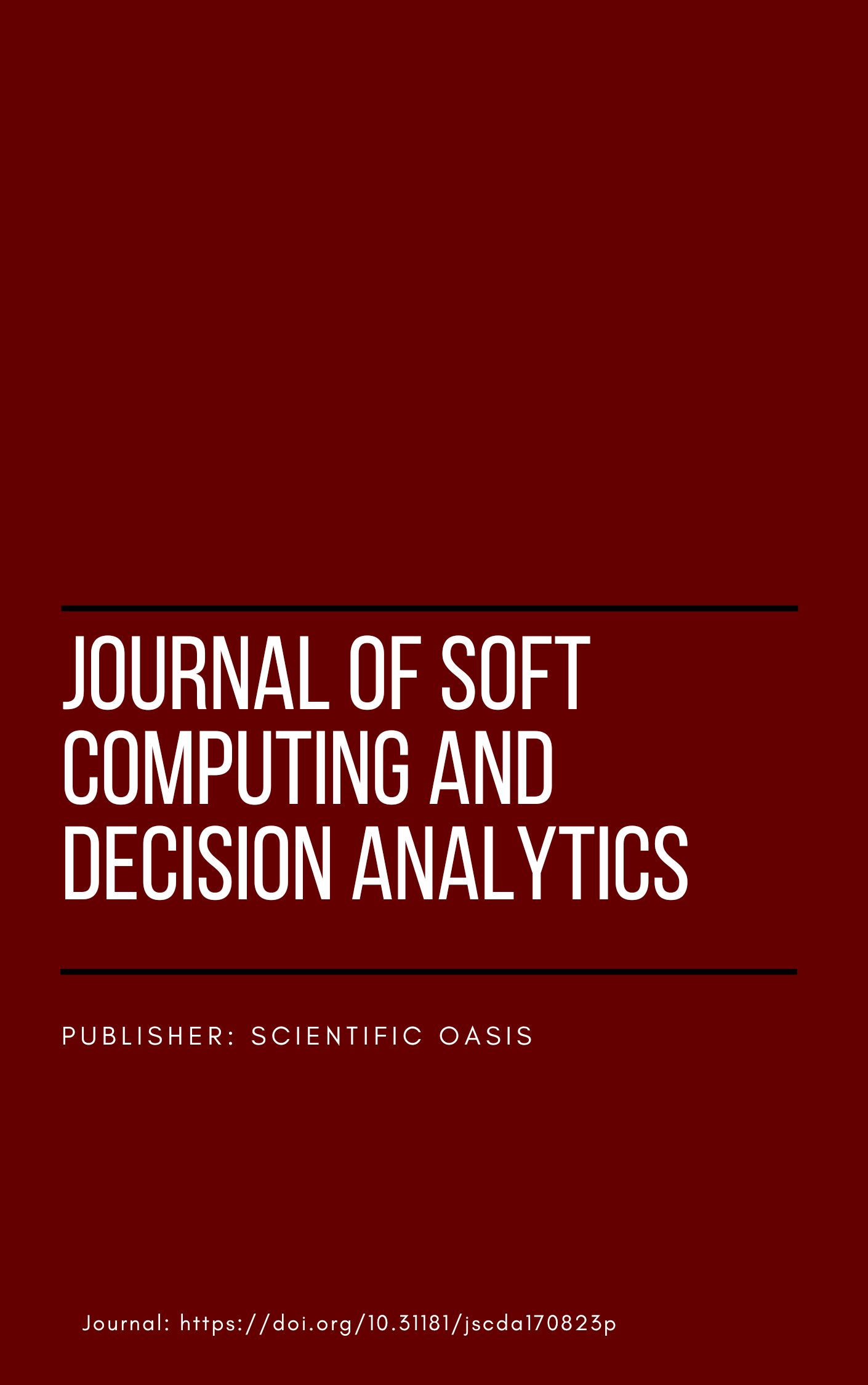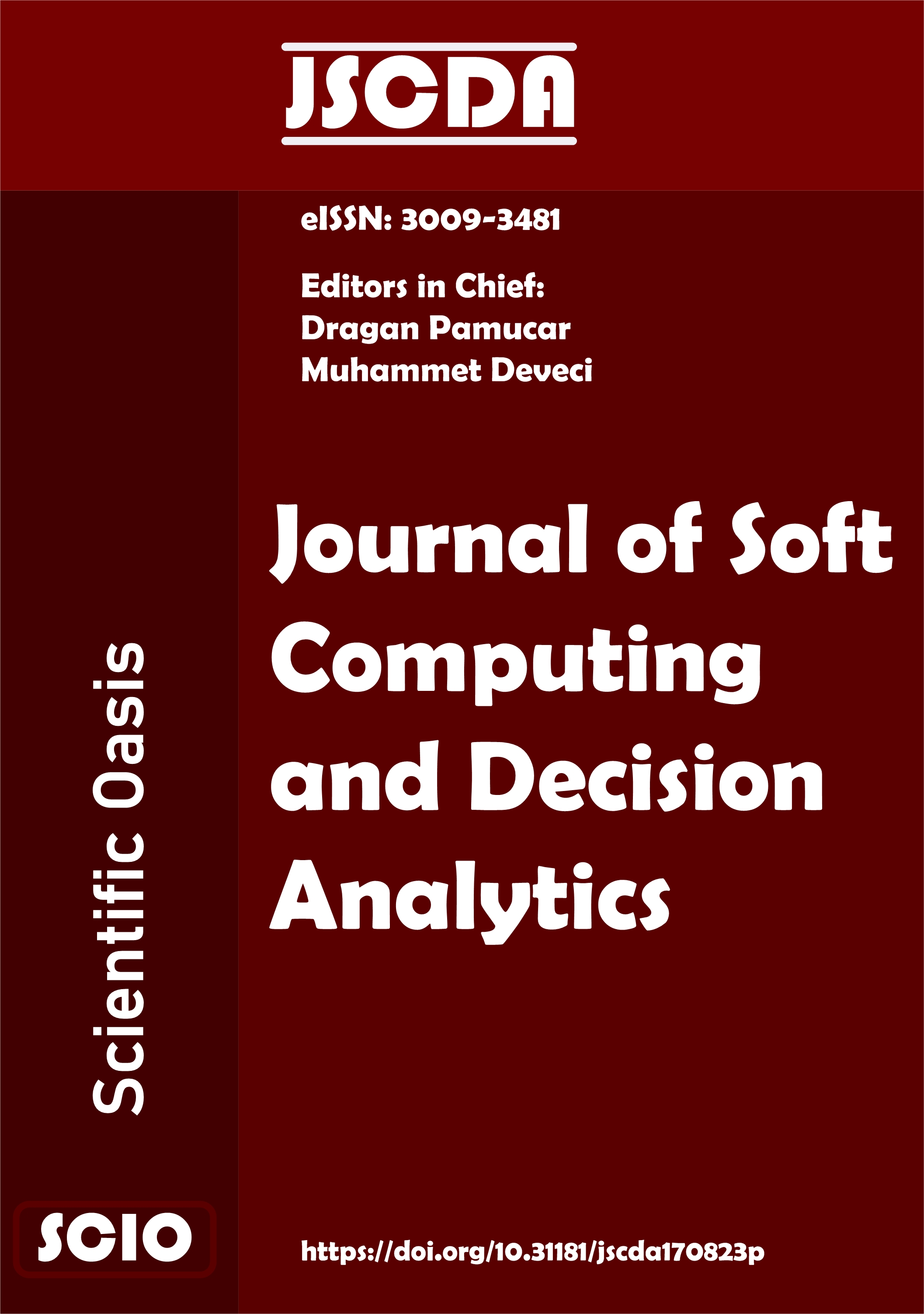Enhancing Financial Performance Evaluation: The MEREC-RBNAR Hybrid Method for Sustainability-Indexed Companies
DOI:
https://doi.org/10.31181/jscda21202444Keywords:
Financial Performance, Sustainability Index , Method Based on the Removal Effects of Criteria, Reference-Based Normalization Alternative Ranking, MEREC, RBNARAbstract
Todays, companies are evaluated not only based on their financial activities but also in terms of their attitudes towards environmental, social, and governance (ESG) activities. In this context, companies are indexed based on their sustainability levels, striving to improve both their sustainability and financial levels simultaneously. The main objective of this research is to evaluate and compare the financial performance of companies listed in the sustainability index. To determine the financial performance of companies in the sustainability index, this research develops and proposes the MEREC (Method Based on the Removal Effects of Criteria) - RBNAR (Reference-Based Normalization Alternative Ranking) hybrid method. Additionally, financial ratios are used as criteria for evaluating companies' financial performance. The weights of financial ratios are calculated using the MEREC method, while the RBNAR method determines companies' financial performances. The application of the MEREC-RBNAR hybrid method is presented through a case study aiming to identify the financial performance of companies listed in the Istanbul Stock Exchange's sustainability index for the year 2022. Furthermore, in this research, companies' financial performance levels are determined by considering the averages of financial ratios of companies listed in the sustainability index, using reference-based normalization processes. The research concludes that the most critical criterion in determining the financial performance of companies in the sustainability index is Return on Equity (ROE). MAVI Clothing Industry and Trade Inc. is identified as the company with the highest financial performance level.
References
Batista, A. A. D. S., & Francisco, A. C. D. (2018). Organizational sustainability practices: A study of the firms listed by the corporate sustainability index. Sustainability, 10(1), 226. https://doi.org/10.3390/su10010226.
Dmuchowski, P., Dmuchowski, W., Baczewska-Dąbrowska, A. H., & Gworek, B. (2023). Environmental, social, and governance (ESG) model; impacts and sustainable investment–Global trends and Poland's perspective. Journal of Environmental Management, 329, 117023. https://doi.org/10.1016/j.jenvman.2022.117023.
Hao, X., & Fu, W. (2023). Innovation with ecological sustainability: does corporate environmental responsibility matter in green innovation?. Journal of Economic Analysis, 2(3), 21-42. https://doi.org/10.58567/jea02030002.
BIST (2023). Sürdürülebilirlik Endeksleri, Borsa İstanbul. https://www.borsaistanbul.com/tr/sayfa/165/bist-surdurulebilirlik-endeksleri (Access Date: 23.05.2024).
Nyantakyi, G., Atta Sarpong, F., Adu Sarfo, P., Uchenwoke Ogochukwu, N., & Coleman, W. (2023). A boost for performance or a sense of corporate social responsibility? A bibliometric analysis on sustainability reporting and firm performance research (2000-2022). Cogent Business & Management, 10(2), 2220513. https://doi.org/10.1080/23311975.2023.2220513.
Khatter, A., White, L., Pyke, J., & McGrath, M. (2021). Barriers and drivers of environmental sustainability: Australian hotels. International Journal of Contemporary Hospitality Management, 33(5), 1830-1849. https://doi.org/10.1108/IJCHM-08-2020-0929.
Rençber, İ. (2024). Türk Hava Yollarının Kurumsal Sürdürülebilirlik Performansının Entropi ve TOPSIS Yöntemleriyle İncelenmesi. Yönetim Bilimleri Dergisi, 22(52), 597-628. https://doi.org/10.35408/comuybd.1397485.
Sariyer, G., & Taşkın, D. (2022). Clustering of firms based on environmental, social, and governance ratings: Evidence from BIST sustainability index. Borsa Istanbul Review, 22, S180-S188. https://doi.org/10.1016/j.bir.2022.10.009.
Drempetic, S., Klein, C., & Zwergel, B. (2020). The influence of firm size on the ESG score: Corporate sustainability ratings under review. Journal of business ethics, 167(2), 333-360. https://doi.org/10.1007/s10551-019-04164-1.
Güçlü, F., & Göktaş, F. (2023). BIST katilim sürdürülebilirlik endeksi imalat sektörü şirketlerinin finansal performansinin entropi ağirlikli TOPSIS ve PES yöntemleriyle incelenmesi. Uluslararası Bankacılık Ekonomi ve Yönetim Araştırmaları Dergisi, 6(2), 112-135. https://doi.org/10.52736/ubeyad.1394258.
Çıtak, L., & Ersoy, E. (2016). Firmaların BIST Sürdürülebilirlik Endeksine Alınmasına Yatırımcı Tepkisi: Olay Çalışması ve Ortalama Testleri İle Bir Analiz (Investors' Reactions to the Inclusion of Firms in the Bist Sustainability Index: An Analysis by Event Study and Mean-Median Tests). International Journal of Alanya Faculty of Business, 8(1), 43-57. https://ssrn.com/abstract=2775005.
Keshavarz-Ghorabaee, M., Amiri, M., Zavadskas, E. K., Turskis, Z., & Antucheviciene, J. (2021). Determination of objective weights using a new method based on the removal effects of criteria (MEREC). Symmetry, 13(4), 525. https://doi.org/10.3390/sym13040525.
Kara, K., Yalçın, G. C., Çetinkaya, A., Simic, V., & Pamucar, D. (2024). A single-valued neutrosophic CIMAS-CRITIC-RBNAR decision support model for the financial performance analysis: A study of technology companies. Socio-Economic Planning Sciences, 101851. https://doi.org/10.1016/j.seps.2024.101851.
Lin, A. J., & Chang, H. Y. (2019). Business sustainability performance evaluation for taiwanese banks—A hybrid multiple-criteria decision-making approach. Sustainability, 11(8), 2236. https://doi.org/10.3390/su11082236.
Laha, S., & Biswas, S. (2019). A hybrid unsupervised learning and multi-criteria decision making approach for performance evaluation of Indian banks. Accounting, 5(4), 169-184. https://doi.org/10.5267/j.ac.2018.11.001.
Tey, D. J. Y., Gan, Y. F., Selvachandran, G., Quek, S. G., Smarandache, F., Abdel-Basset, M., & Long, H. V. (2019). A novel neutrosophic data analytic hierarchy process for multi-criteria decision making method: A case study in kuala lumpur stock exchange. IEEE access, 7, 53687-53697. https://doi.org/10.1109/ACCESS.2019.2912913.
Anthony, P., Behnoee, B., Hassanpour, M., & Pamucar, D. (2019). Financial performance evaluation of seven Indian chemical companies. Decision Making: Applications in Management and Engineering, 2(2), 81-99. https://doi.org/10.31181/dmame1902021a.
Suvvari, A., & Goyari, P. (2019). Financial performance assessment using Grey relational analysis (GRA) An application to life insurance companies in India. Grey Systems: Theory and Application, 9(4), 502-516. https://doi.org/10.1108/GS-05-2019-0010.
Rodrigues, L., & Rodrigues, L. (2018). Economic-financial performance of the Brazilian sugarcane energy industry: An empirical evaluation using financial ratio, cluster and discriminant analysis. Biomass and bioenergy, 108, 289-296. https://doi.org/10.1016/j.biombioe.2017.11.013.
Perçin, S., & Aldalou, E. (2018). Financial performance evaluation of Turkish airline companies using integrated fuzzy AHP fuzzy TOPSIS model. Uluslararası İktisadi ve İdari İncelemeler Dergisi, 583-598. https://doi.org/10.18092/ulikidince.347925.
Shaverdi, M., Ramezani, I., Tahmasebi, R., & Rostamy, A. A. A. (2016). Combining fuzzy AHP and fuzzy TOPSIS with financial ratios to design a novel performance evaluation model. International Journal of Fuzzy Systems, 18, 248-262. https://doi.org/10.1007/s40815-016-0142-8.
Ozcalici, M., & Bumin, M. (2020). An integrated multi-criteria decision making model with Self-Organizing Maps for the assessment of the performance of publicly traded banks in Borsa Istanbul. Applied Soft Computing, 90, 106166. https://doi.org/10.1016/j.asoc.2020.106166.
Ic, Y. T., Celik, B., Kavak, S., & Baki, B. (2021). Development of a multi-criteria decision-making model for comparing the performance of Turkish commercial banks. Journal of Advances in Management Research, 18(2), 250-272. https://doi.org/10.1108/JAMR-05-2020-0083.
Ghosh, S., & Bhattacharya, M. (2022). Analyzing the impact of COVID-19 on the financial performance of the hospitality and tourism industries: an ensemble MCDM approach in the Indian context. International Journal of Contemporary Hospitality Management, 34(8), 3113-3142. https://doi.org/10.1108/IJCHM-11-2021-1328.
Tavana, M., Khalili-Damghani, K., & Rahmatian, R. (2015). A hybrid fuzzy MCDM method for measuring the performance of publicly held pharmaceutical companies. Annals of Operations Research, 226, 589-621. https://doi.org/10.1007/s10479-014-1738-8.
Makki, A. A., & Alqahtani, A. Y. (2023). Capturing the effect of the COVID-19 pandemic outbreak on the financial performance disparities in the energy sector: A Hybrid MCDM-Based evaluation approach. Economies, 11(2), 61. https://doi.org/10.3390/economies11020061.
Işık, C., Türkkan, M., Marbou, S., & Gül, S. (2024). Stock Market Performance Evaluation of Listed Food and Beverage Companies in Istanbul Stock Exchange with MCDM Methods. Decision Making: Applications in Management and Engineering, 7(2), 35-64. https://doi.org/10.31181/dmame722024692.
Shih, H. S., Shyur, H. J., & Lee, E. S. (2007). An extension of TOPSIS for group decision making. Mathematical and computer modelling, 45(7-8), 801-813. https://doi.org/10.1016/j.mcm.2006.03.023.
Aytekin, A. (2021). Comparative Analysis of the Normalization Techniques in the Context of MCDM Problems. Decision Making: Applications in Management and Engineering, 4(2), 1-25. https://doi.org/10.31181/dmame210402001a.
Moghimi, R., & Anvari, A. (2014). An integrated fuzzy MCDM approach and analysis to evaluate the financial performance of Iranian cement companies. The International Journal of Advanced Manufacturing Technology, 71(1), 685-698. https://doi.org/10.1007/s00170-013-5370-6.
Abdel-Basset, M., Ding, W., Mohamed, R., & Metawa, N. (2020). An integrated plithogenic MCDM approach for financial performance evaluation of manufacturing industries. Risk management, 22, 192-218. https://doi.org/10.1057/s41283-020-00061-4.
Alsanousi, A. T., Alqahtani, A. Y., Makki, A. A., & Baghdadi, M. A. (2024). A Hybrid MCDM Approach Using the BWM and the TOPSIS for a Financial Performance-Based Evaluation of Saudi Stocks. Information, 15(5), 258. https://doi.org/10.3390/info15050258.
Ferreira, F. A., Ilander, G. O. P. B., & Ferreira, J. J. (2019). MCDM/A in practice: methodological developments and real-world applications. Management Decision, 57(2), 295-299. https://doi.org/10.1108/MD-02-2019-017.
Baydaş, M., & Pamučar, D. (2022). Determining objective characteristics of MCDM methods under uncertainty: an exploration study with financial data. Mathematics, 10(7), 1115. https://doi.org/10.3390/math10071115.
Santosa, P. W., Rahayu, S. I., Simon, Z. Z., & Santoso, P. W. (2023). Moderating role of audit quality and firm size on pretax profit margin and related party transactions: evidence from Indonesia. Business: Theory and Practice, 24(1), 291-300. https://doi.org/10.3846/btp.2023.17946.
Heikal, M., Khaddafi, M., & Ummah, A. (2014). Influence analysis of return on assets (ROA), return on equity (ROE), net profit margin (NPM), debt to equity ratio (DER), and current ratio (CR), against corporate profit growth in automotive in Indonesia Stock Exchange. International Journal of Academic Research in Business and Social Sciences, 4(12), 101. http://dx.doi.org/10.6007/IJARBSS/v4-i12/1331.
Akdemir, D. M., & Şimşek, O. (2023). A Financial Performance Evaluation via Hybrid MCDM methods: A case of Amazon. com Inc. Istanbul Business Research, 52(1), 199-232. https://doi.org/10.26650/ibr.2023.52.994729.
Wu, H. Y., Tzeng, G. H., & Chen, Y. H. (2009). A fuzzy MCDM approach for evaluating banking performance based on Balanced Scorecard. Expert systems with applications, 36(6), 10135-10147. https://doi.org/10.1016/j.eswa.2009.01.005.
Zhu, L. (2022). Sharp Bounds for a Generalized Logarithmic Operator Mean and Heinz Operator Mean by Weighted Ones of Classical Operator Ones. Mathematics, 10(10), 1617. https://doi.org/10.3390/math10101617.
Downloads
Published
Issue
Section
License
Copyright (c) 2024 Scientific Oasis

This work is licensed under a Creative Commons Attribution 4.0 International License.
















